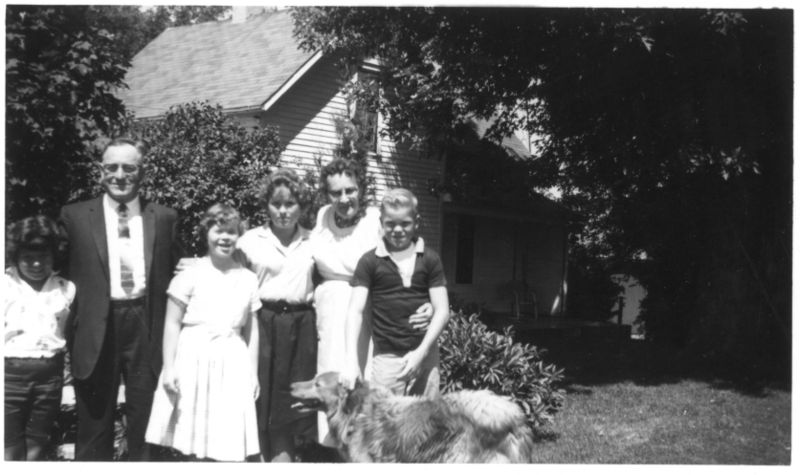
It’s always hard to get the dog to look at the camera; more difficult, it seems, than to center the photo. Dated by photolab, August 1961.
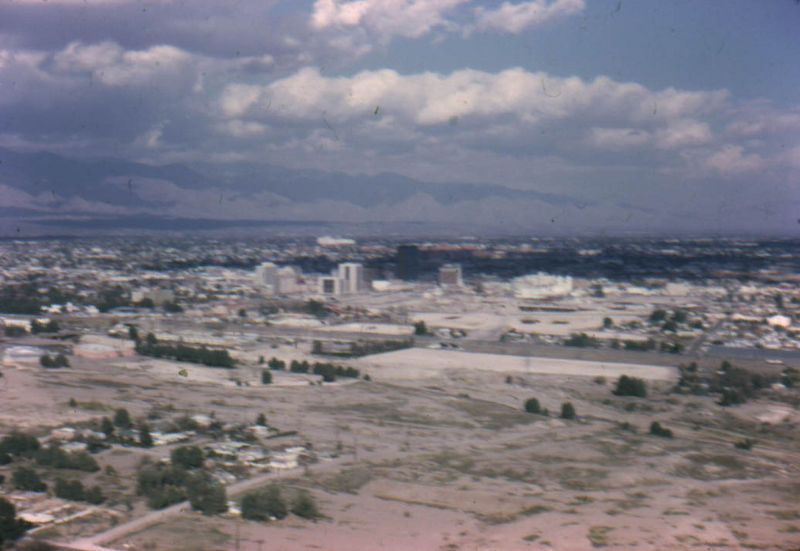
The perspective and content of this photo requires me to get a little geeky. When I first looked at it, I immediately connected it to a scene from Star Wars — Luke and ObiWan are on their way to save the universe, and in procuring a ship they stop on a cliff overlooking the spaceport. ObiWan warns: “Mos Eisley spaceport. You will never find a more wretched hive of scum and villainy.”
The actual city, I don’t know — it appears to be in Arizona, given the content of other images in these slides, and the number of tall buildings would indicate it’s not a tiny town. The odds of finding a Corellian starship for hire are probably low, though.
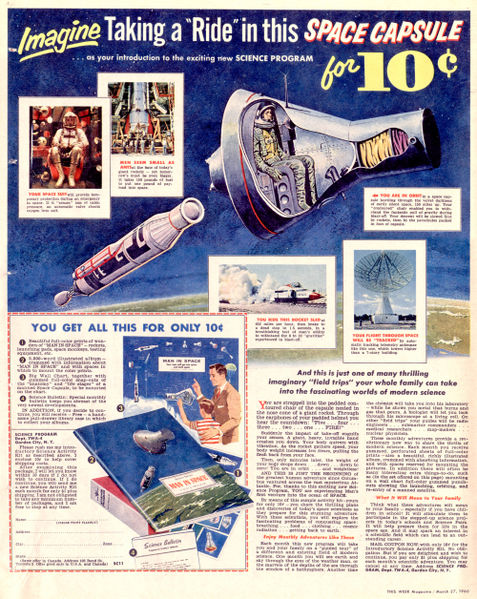 In 1960, you could drop a dime in the mail and get yourself some genuine space-flight experience! The Science Program was a subscription service, delivering a booklet devoted to a single subject each month. Ten cents was the introductory offer, but future booklets cost a dollar (plus shipping). Subscribers also got posters, star-charts, and other helpful activities to help teach about the varied topics, from nuclear power to cartography.
In 1960, you could drop a dime in the mail and get yourself some genuine space-flight experience! The Science Program was a subscription service, delivering a booklet devoted to a single subject each month. Ten cents was the introductory offer, but future booklets cost a dollar (plus shipping). Subscribers also got posters, star-charts, and other helpful activities to help teach about the varied topics, from nuclear power to cartography.
Take a close look at the date, though: this advertisement was printed on the back of the 27 March 1960 edition of This Week magazine…a full year before the USSR and USA launched their respective manned spaceflights. The potential for wild speculation and amateurish writing was ripe, but the Science Service was above such things. Established in the 1920s, the Science Service was a newswire for scientific thought, sponsored and edited by scientists for accuracy and clarity to the layperson. These booklets were carefully written for accuracy, as much information as they had in the 1960s, and certainly inspired the minds of today’s scientists and engineers. That is, if their parents could come up with a buck a month to keep the sticker books coming.
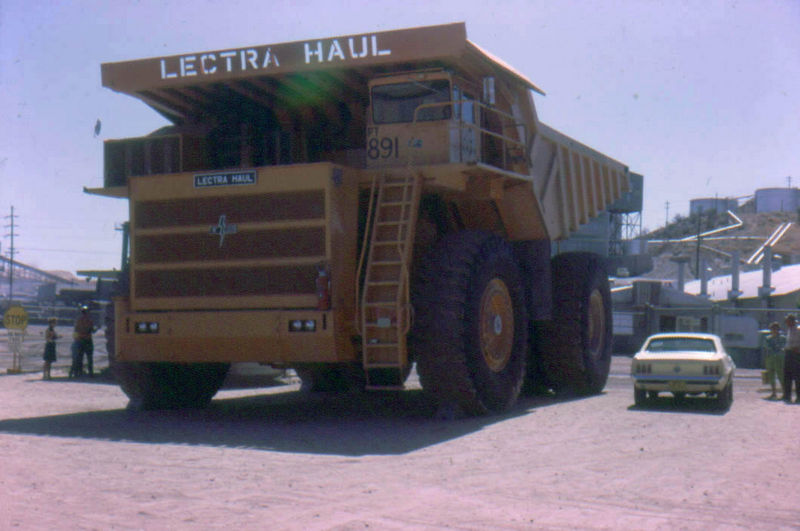 This undated photo, from the 1960s, shows just how big a Lectra Haul is. That, on the right, is a mid-1960s Ford Mustang. If the people standing next to the Mustang were to stand on its roof, they might just reach the top of the Lectra Haul’s tire. This is actually a small one; although this was big in the early 1960s, as the decade progressed massive moving machines were growing in size at an alarming rate. This one could carry 85 tons, but by the end of the 1960s their manufacturer, Unit Rig, had moved on to bigger, more immense machines capable of carrying hundreds of tons at a time.
This undated photo, from the 1960s, shows just how big a Lectra Haul is. That, on the right, is a mid-1960s Ford Mustang. If the people standing next to the Mustang were to stand on its roof, they might just reach the top of the Lectra Haul’s tire. This is actually a small one; although this was big in the early 1960s, as the decade progressed massive moving machines were growing in size at an alarming rate. This one could carry 85 tons, but by the end of the 1960s their manufacturer, Unit Rig, had moved on to bigger, more immense machines capable of carrying hundreds of tons at a time.
Now, for this photo’s origins — this came from the same set of slides as the 4H parade, but the rest were all rather scattered about…no real order. So, I’m scanning them in no particular order. I do know it was taken in the 1960s, based on other slides with marked dates. A large number of the slides are taken in Arizona or California, although pictures of houses and interiors are quite clearly in Arizona. The background doesn’t look like Arizona to me, though: distant oil storage facilities, overground pipelines, lots of ‘nothin, it looks more like Oklahoma or Texas. Turns out, Arizona has an oil industry, so its likely that an oil company would have bought a Lectra Haul from Unit Rig (which also manufactured electrically-powered oil wells and equipment), and left it parked out where tourists could gawk at it.
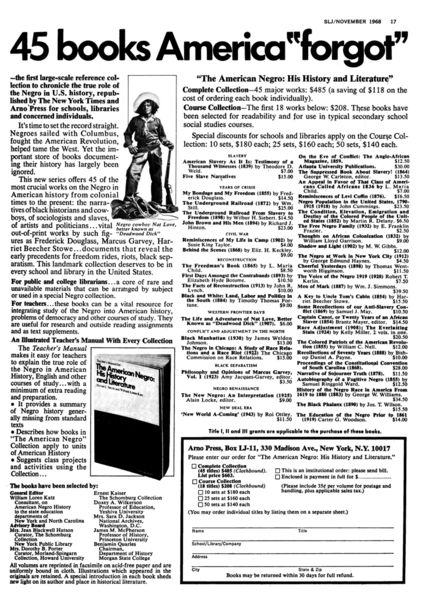 This advertisement appeared in the November 1968 issue of School Library Journal; I’d wager that “forgot” is in shock quotes because they weren’t truly forgotten (Sojourner Truth, Uncle Tom’s Cabin, etc), but for the most part the books in this collection were somewhat obscure, given the subject matter and the educational system at the time. Negros were barely considered second-class citizens even in 1968 (just a couple years before I was born), so “forgot” can also apply to schools who neglected to include Negro history on their bookshelves among the Anglo-centric histories that are our libraries are still overly heavy with. This expansive collection would definitely prove to be an encompassing addition to a library, giving the probably Negro-lax knowledge of the librarians a break, removing their need to research and compile a list. Here it was, all lumped together, ready to be purchased as a $485 chunk. It’d probably look good on the budget request; to the probably overly-white adminstrative groups overseeing library acquisitions at the time, one $485 one-time purchase would look better than 45 individual purchases spread out over months as the books are discovered.
This advertisement appeared in the November 1968 issue of School Library Journal; I’d wager that “forgot” is in shock quotes because they weren’t truly forgotten (Sojourner Truth, Uncle Tom’s Cabin, etc), but for the most part the books in this collection were somewhat obscure, given the subject matter and the educational system at the time. Negros were barely considered second-class citizens even in 1968 (just a couple years before I was born), so “forgot” can also apply to schools who neglected to include Negro history on their bookshelves among the Anglo-centric histories that are our libraries are still overly heavy with. This expansive collection would definitely prove to be an encompassing addition to a library, giving the probably Negro-lax knowledge of the librarians a break, removing their need to research and compile a list. Here it was, all lumped together, ready to be purchased as a $485 chunk. It’d probably look good on the budget request; to the probably overly-white adminstrative groups overseeing library acquisitions at the time, one $485 one-time purchase would look better than 45 individual purchases spread out over months as the books are discovered.
Here’s why Google Books, Project Gutenberg, Print-On-Demand, and other electronic publishing services are instrumental in modern education: The list of “forgotten” books are hardly forgotten today. Where, forty years ago, a library had to find nearly $500 — probably a months’ salary for one good librarian, or a half-dozen part-timer circulation desk workers — nearly all of the books are available online today, most free to anyone with an internet connection…which, incidentally, is free in most libraries today.
Why did I mention Print-On-Demand? The 1968 editions advertised here from Arno Press, particularly the non-public-domain-editions, are still shown as available according to Amazon via Ayer Publishing with a 1-3 week wait. That sort of wait time, the type of business Ayer runs, and the existing 1968 publishing date means that this book, when ordered from Amazon, is printed in an instant on high-speed printers, bound and jacketed, and then shipped out in one constant motion. These modern technologies make available books that were once obscure and elusive. Once upon a time, you had to be a librarian with a big budget. Today, these books are available to anybody, in a comparative (or literal) instant, thanks to computers and publishing revolutions.
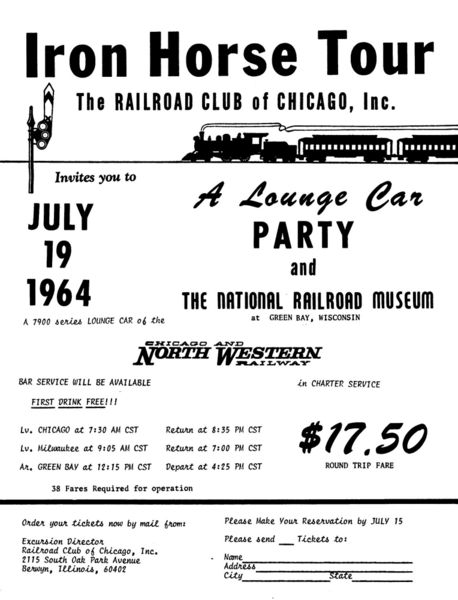 On July 19, 1964, a group of railroad aficionados piled aboard a 7900 series lounge car belonging to the Chicago and North Western Railway, en route to the National Railroad Museum in Green Bay, Wisconsin. The Railroad Club of Chicago sponsored this ‘lounge car party,’ bringing along friends from Milwaukee along the way, and providing one free drink in the fare. I imagine that a car-full of railroad guys — at least 38 of them — in a moving bar for five hours straight were a mighty friendly bunch when they disembarked in Green Bay. I’m pleased to see that the club is still around. Too often, ‘archaic’ clubs like these dwindle in numbers as their members age and fall away, but railroad people are an odd bunch; the romance of the rails meets men’s natural affinity for huge, loud, mechanical machines, and you end up with some fun-loving guys who’ll pile on a train and road-trip to Green Bay to see more trains. Today, they promote rail travel, discuss community history revolving around trains, and remind everyone that, even though trains are disappearing, they meant a lot to the United States we live in.
On July 19, 1964, a group of railroad aficionados piled aboard a 7900 series lounge car belonging to the Chicago and North Western Railway, en route to the National Railroad Museum in Green Bay, Wisconsin. The Railroad Club of Chicago sponsored this ‘lounge car party,’ bringing along friends from Milwaukee along the way, and providing one free drink in the fare. I imagine that a car-full of railroad guys — at least 38 of them — in a moving bar for five hours straight were a mighty friendly bunch when they disembarked in Green Bay. I’m pleased to see that the club is still around. Too often, ‘archaic’ clubs like these dwindle in numbers as their members age and fall away, but railroad people are an odd bunch; the romance of the rails meets men’s natural affinity for huge, loud, mechanical machines, and you end up with some fun-loving guys who’ll pile on a train and road-trip to Green Bay to see more trains. Today, they promote rail travel, discuss community history revolving around trains, and remind everyone that, even though trains are disappearing, they meant a lot to the United States we live in.
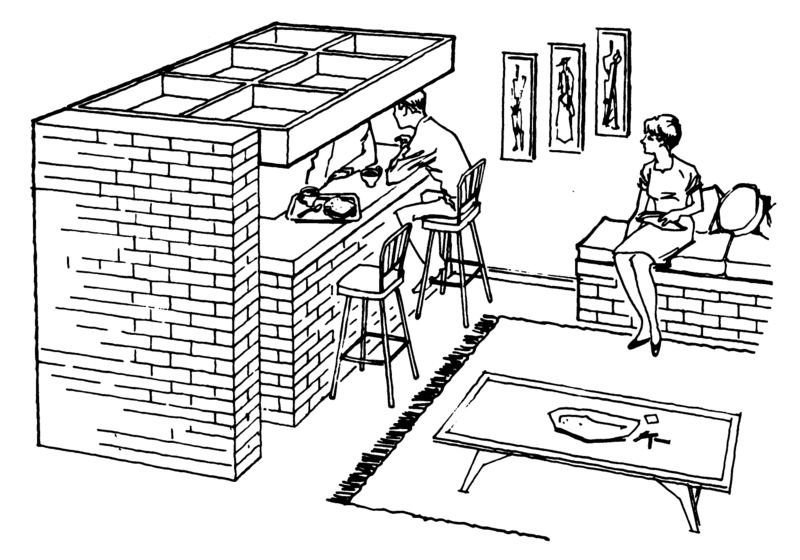
That swanky snack bar isn’t a weekend project from Handy Andy — it’s secret is that the instant the Emergency Broadcast System begins to pierce the air, the snack bar converts into a fallout shelter. The booklet “Fallout Protection for Homes with Basements” — available in online and hard-copy formats, was produced by Civil Defense and mailed out to homeowners who completed a questionnaire about their house’s construction. Based on those answers, using an ‘electronic computer‘, the CD calculated how much radiation protection your unshielded basement can provide…and offer a lot of advice on what to do if your basement comes up short. Unlike the traditional image of a fallout-shelter as an impenetrable fortress buried in the back yard, these fallout shelter suggestions are practical, cheap, simple…and aren’t a waste of space if nuclear war never happens (knock on wood). What surprised me is the fact that fallout doesn’t behave like a gas — it falls like snow, piles up on the ground, but it’s the radiation the fallout emits that is what will get you. The fallout shelters don’t have doors, and the booklet says several times that if you must go do important things (read: use the toilet), you can wander about for a few minutes at a time. If you’re hiding out under a converted snack bar, at least you won’t have to go far for a can of peanuts.
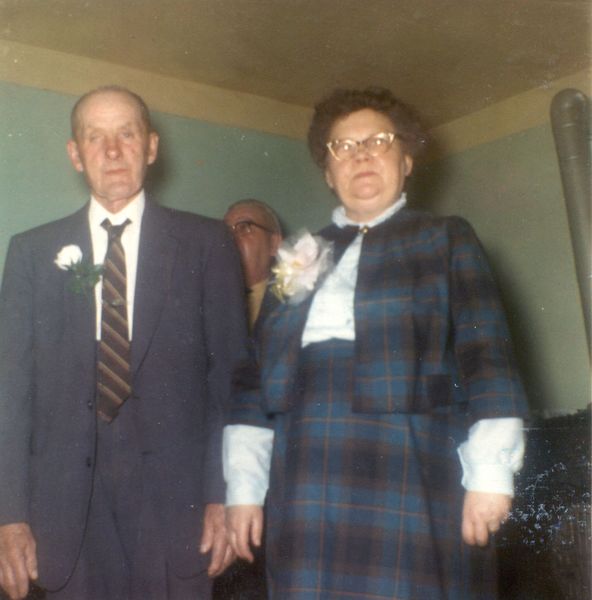 I’ve started scanning a new family photo album — another one from Wisconsin, and this one had all the ‘good’ photos removed, leaving the ones I’m scanning behind. Why were they rejected? I can’t tell.
I’ve started scanning a new family photo album — another one from Wisconsin, and this one had all the ‘good’ photos removed, leaving the ones I’m scanning behind. Why were they rejected? I can’t tell.
Most of these photos are also unmarked — but the one to the right was important enough to be captioned: “Bertha and Husband.” I wonder which one’s Bertha?
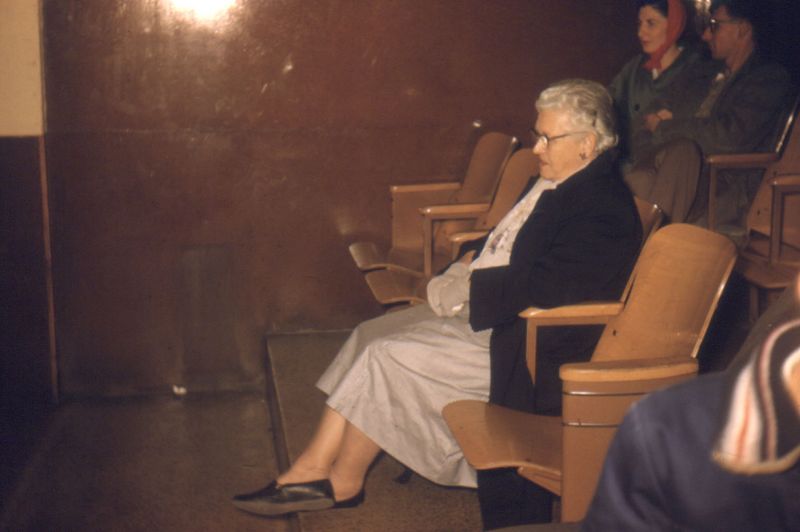 Whistler’s Mother (otherwise known as Arrangement in Gray and Black No. 1) is an iconic image in our culture, recalling a Victorian silence and respectability. Mrs. Melby’s Mother, above, spent Halloween 1960 at a bowling alley. My, how times change is a little less than a century! Not quite as much as you may think, though — the style of dress is similarly modest, although Mrs. Melby has gone stocking-free and is showing a little ankle. Her chair is similarly spartan, although anyone who attended a high school built earlier than 1960 is probably intimately familiar with such folding seats; many a small finger has been bit by those steel hinges while screwing around during an oh-so-important school assembly in the auditorium.
Whistler’s Mother (otherwise known as Arrangement in Gray and Black No. 1) is an iconic image in our culture, recalling a Victorian silence and respectability. Mrs. Melby’s Mother, above, spent Halloween 1960 at a bowling alley. My, how times change is a little less than a century! Not quite as much as you may think, though — the style of dress is similarly modest, although Mrs. Melby has gone stocking-free and is showing a little ankle. Her chair is similarly spartan, although anyone who attended a high school built earlier than 1960 is probably intimately familiar with such folding seats; many a small finger has been bit by those steel hinges while screwing around during an oh-so-important school assembly in the auditorium.
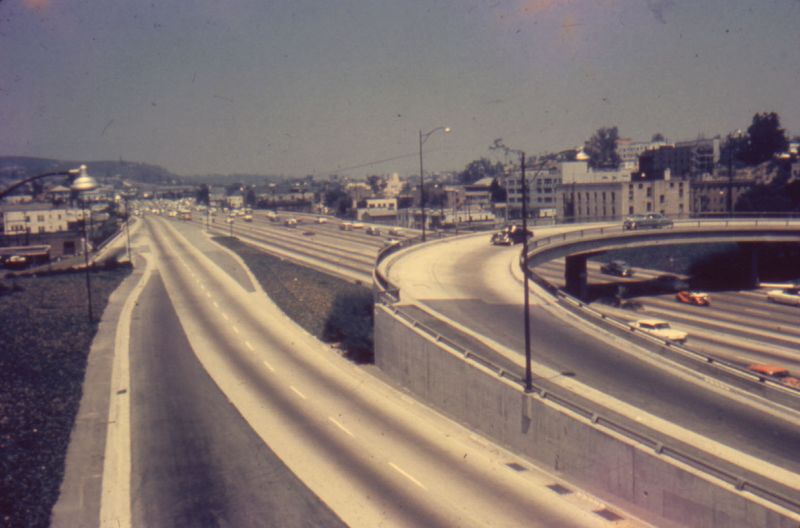
Well, here we’ve got an entirely different view of the Harbor Freeway (compared to a few weeks ago). California’s pride in their municipal freeways was immense: in theory, they provided an escape from the crowded streets of other metropolitan areas, and allowed for relaxing suburban living while working in the city. Today, we see this as Sprawl, a bad thing, but in the sixties it was The Way Of The Future.
see also: history of future la * 1970s concept la proposal * interior of lax * more 60s freeway (1) (2)